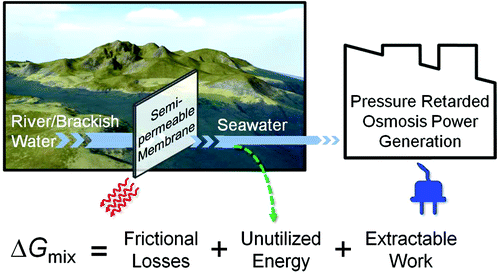A new genre of electric power-generating stations could supply electricity for more than a half billion people by tapping just one-tenth of the global potential of a little-known energy source that exists where rivers flow into the ocean, a new analysis has concluded. A report on the process — which requires no fuel, is sustainable and releases no carbon dioxide (the main greenhouse gas) — appears in ACS' journal Environmental Science & Technology.
Menachem Elimelech and Ngai Yin Yip explain that the little-known process, called pressure-retarded osmosis (PRO), exploits the so-called salinity gradient — or difference in saltiness — between freshwater and seawater. In PRO, freshwater flows naturally by osmosis through a special membrane to dilute seawater on the other side. The pressure from the flow spins a turbine generator and produces electricity. The world's first PRO prototype power plant was inaugurated in Norway in 2009. With PRO appearing to have great potential, the scientists set out to make better calculations on how much it actually could contribute to future energy needs under real-world conditions.
Elimelech and Yip concluded that PRO power-generating stations using just one-tenth of the global river water flow into the oceans could generate enough power to meet the electricity needs of 520 million people, without emitting carbon dioxide. The same amount of electricity, if produced by a coal-fired power plant, would release over one billion metric tons of greenhouse gases each year.
More information: “Thermodynamic and Energy Efficiency Analysis of Power Generation from Natural Salinity Gradients by Pressure Retarded Osmosis” Environ. Sci. Technol., Article ASAP. DOI: 10.1021/es300060m
Abstract
The Gibbs free energy of mixing dissipated when fresh river water flows into the sea can be harnessed for sustainable power generation. Pressure retarded osmosis (PRO) is one of the methods proposed to generate power from natural salinity gradients. In this study, we carry out a thermodynamic and energy efficiency analysis of PRO work extraction. First, we present a reversible thermodynamic model for PRO and verify that the theoretical maximum extractable work in a reversible PRO process is identical to the Gibbs free energy of mixing. Work extraction in an irreversible constant-pressure PRO process is then examined. We derive an expression for the maximum extractable work in a constant-pressure PRO process and show that it is less than the ideal work (i.e., Gibbs free energy of mixing) due to inefficiencies intrinsic to the process. These inherent inefficiencies are attributed to (i) frictional losses required to overcome hydraulic resistance and drive water permeation and (ii) unutilized energy due to the discontinuation of water permeation when the osmotic pressure difference becomes equal to the applied hydraulic pressure. The highest extractable work in constant-pressure PRO with a seawater draw solution and river water feed solution is 0.75 kWh/m3 while the free energy of mixing is 0.81 kWh/m3—a thermodynamic extraction efficiency of 91.1%. Our analysis further reveals that the operational objective to achieve high power density in a practical PRO process is inconsistent with the goal of maximum energy extraction. This study demonstrates thermodynamic and energetic approaches for PRO and offers insights on actual energy accessible for utilization in PRO power generation through salinity gradients.
Provided by American Chemical Society



















